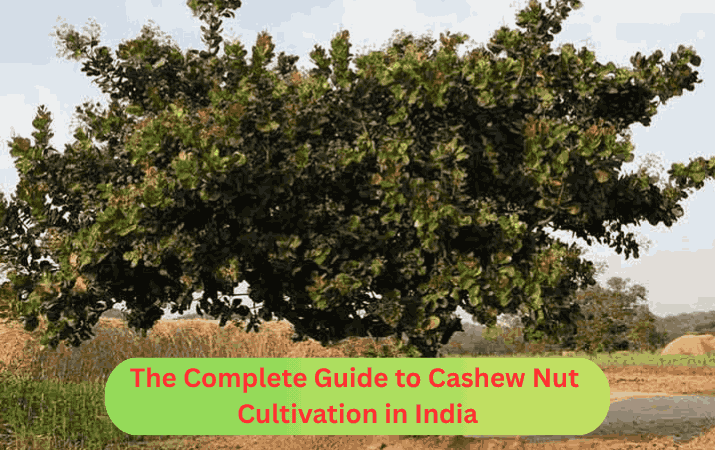
The Complete Guide to Cashew Nut Cultivation in India

Introduction
For businesses in tropical areas, cashew nuts are one of the most famous and valuable foods. Some of India’s most important farmers, especially those in coastal states, depend on growing cashews to make a living. That makes the country one of the biggest players in the world nut trade; it both grows peanuts for its people to eat and sells them to other countries. From the temperature and soil requirements to harvesting and processing, this guide covers everything you need to know about growing cashew nuts in India.
1. A Quick Look of Cashew in India
Cashew (Anacardium occidentale L.) was first brought to India by Portuguese traders in the 16th century, mainly to prevent soil erosion along the coastal belt. Gradually, it’s delicious nuts became well known for their taste, health benefits, and export value.
India is now one of the world’s top producers and exporters of cashews. Kerala, Maharashtra, Goa, Tamil Nadu, Andhra Pradesh, Karnataka, Odisha, and West Bengal are the primary places where it is grown. In the southern and western sections of the country, cashew growing provides jobs in shelling, drying, and processing, which helps both big farms and small growers.
2. Ideal Climate for Cashew Cultivation
Cashew trees thrive in tropical climates with moderate temperatures and ample sunlight.
- Temperature Range: 20°C to 35°C is ideal for optimal growth.
- Rainfall: Annual rainfall between 1000 and 2000 mm supports good yield, though well-drained soils are essential to prevent root rot.
- Elevation: Grows well up to 700 metres above sea level.
- Sunlight: Requires abundant sunlight throughout the year for flowering and fruiting.
Regions with distinct dry and wet seasons are best for cashew cultivation, as the dry season helps in flowering and nut maturity.
3. Suitable Soil Conditions
Cashew trees are hardy and can adapt to various soil types, but they prefer well-drained sandy loam or red soils with an adequate organic content
- Soil pH: Slightly acidic to neutral (5.5–7.0) is ideal.
- Avoid: Waterlogged or heavy clay soils, which can damage the roots.
Farmers often prepare land by removing weeds, levelling it, and creating contour bunds to reduce soil erosion—especially in hilly regions.
4. Propagation and Planting Methods
Cashew propagation can be done through seeds or grafting.
- Seed Propagation: Simple but can lead to variable yield and nut quality.
- Softwood Grafting: Preferred method for commercial plantations as it ensures uniformity and higher productivity.
Planting Season: The best time for planting is at the onset of the monsoon. Pits of size 60 cm³ are dug and filled with topsoil mixed with organic manure. Spacing typically varies between 7m × 7m or 8m × 8m, depending on soil fertility and variety.
5. Popular Cashew Varieties in India
Research institutions such as the Directorate of Cashew Research (DCR) and state agricultural universities have developed several improved cashew varieties.
The following are some of the popular varieties:
- Vengurla-4 and Vengurla-7 (Maharashtra)
- Bhaskara (Kerala)
- Ullal-1 and Ullal-3 (Karnataka)
- BPP-8 and NRCC Selection-2 (Andhra Pradesh)
- Dhana and Jhargram-1 (Odisha & West Bengal)
These varieties are known for high yield, better kernel recovery, and disease resistance.
6. Crop Management and Care
Effective management practices ensure high productivity and healthy trees.
- Weed Control: Regular weeding and mulching help retain soil moisture and reduce nutrient competition.
- Fertilization: Apply organic compost and balanced NPK fertilizers annually. Recommended dose is 500g nitrogen, 125g phosphorus, and 125g potassium per mature tree.
- Pruning: Light pruning after harvest promotes new shoot growth and better flowering.
- Pest and Disease Control: Major pests include tea mosquito bugs, stem borers, and root grubs. Spraying neem-based solutions or approved pesticides can control infestations.
7. Flowering and Harvesting
- Cashew trees begin flowering after 3 years of planting and reach full production around 8 to 10 years.
- Flowering occurs during the dry season (December–March), followed by fruiting and nut formation.
- The cashew apple and nut mature from February to May, depending on the region.
- Harvesting involves collecting the fallen fruits manually and separating the nuts from the apples. The nuts are then dried for several days to reduce moisture content before shelling.
8. Processing and Value Addition
Cashew processing involves several steps:
- Drying and Roasting: Nuts are sun-dried and roasted to make shelling easier.
- Shelling: The outer shell is cracked open to extract the kernel.
- Peeling: Removing the thin testa layer covering the kernel.
- Grading: Kernels are sorted based on size and colour.
- Packaging: Finally, cashews are packed for domestic markets or export.
Value-added products like roasted, salted, and flavoured cashews, cashew butter, and cashew apple juice further increase profitability for farmers and processors.
9. Economic Importance and Export Potential
- India’s cashew industry plays a vital role in both agriculture and trade. The country exports processed cashew kernels to the USA, UAE, Netherlands, Japan, and the UK.
- The export of cashew kernels contributes significantly to foreign exchange earnings. The domestic market has also grown, with rising demand for healthy snacks and plant-based ingredients.
- Cashew cultivation supports sustainable rural development, creating employment opportunities in farming, processing, and packaging sectors.
10. Challenges and Future Outlook
Cashew farmers face challenges like fluctuating prices, pest attacks, labour shortages, and climate change impacts. To overcome these issues, the focus is shifting towards:
- Adopting climate-resilient varieties
- Using organic and sustainable farming methods
- Promoting mechanization in processing
- Enhancing research and farmer training programs
With growing global demand and support from the Indian government’s agricultural policies, the future of cashew cultivation looks bright and promising.
Conclusion
Cashew nut cultivation in India represents a perfect blend of tradition, sustainability, and opportunity. From small farmers to large-scale processors, everyone contributes to the growth of this valuable crop. By adopting improved farming practices and technology, India can continue to strengthen its position as a leading producer and exporter of premium-quality cashew nuts.



